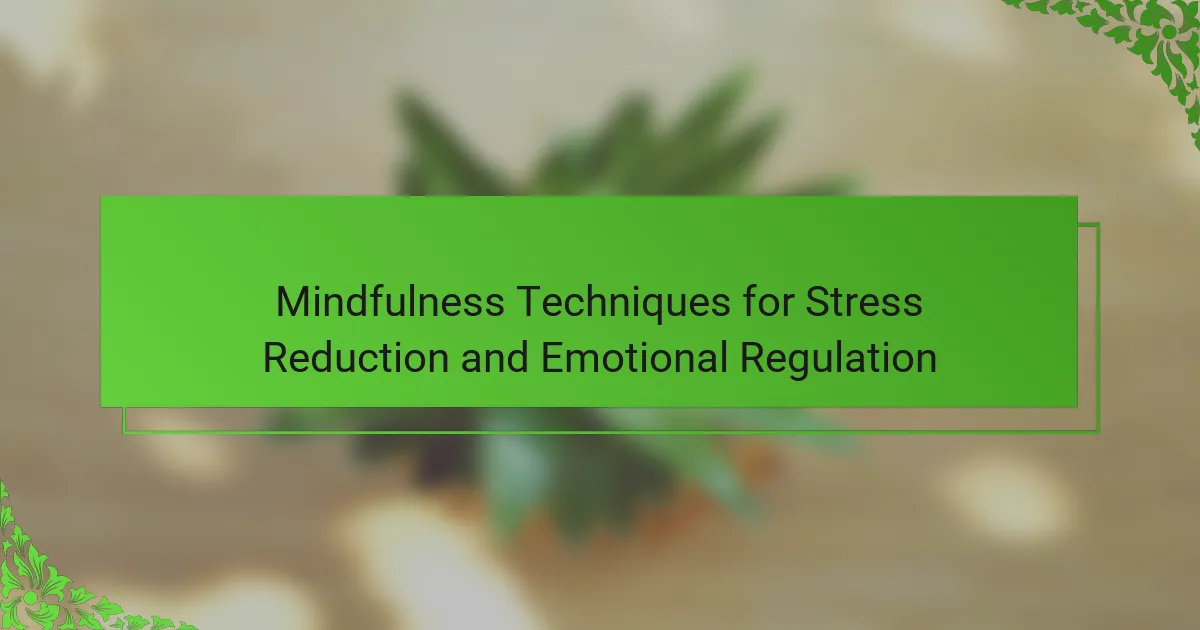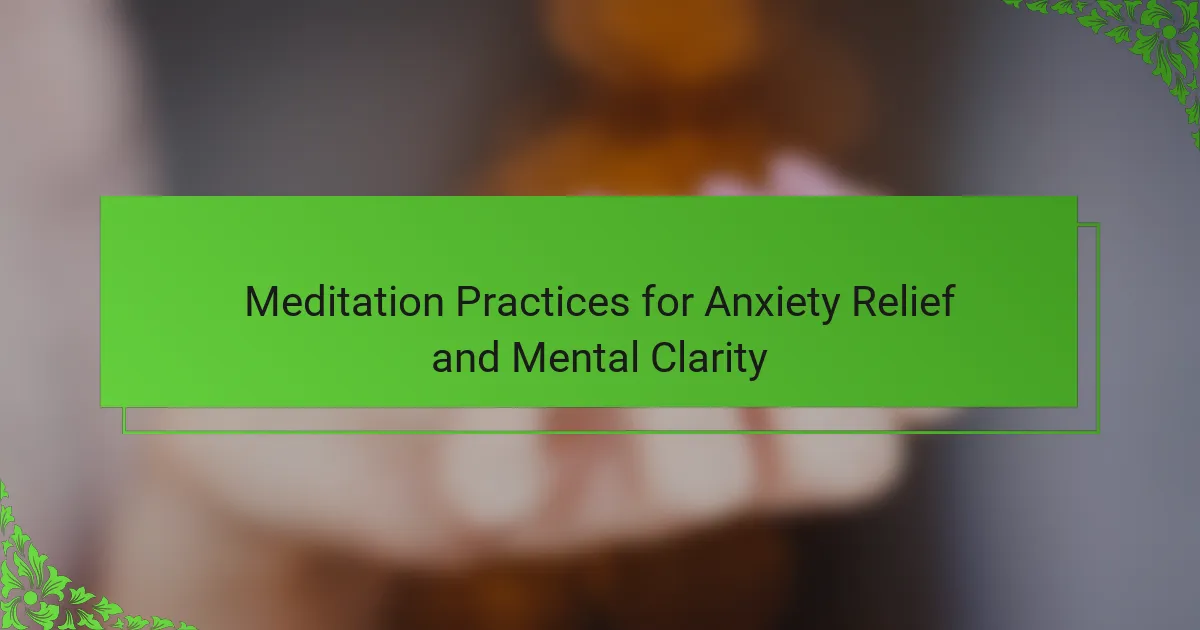Mindfulness techniques effectively reduce stress and enhance emotional regulation. This article explores various practices, including meditation and deep breathing, that promote present-moment awareness. It also addresses cultural adaptations and unique attributes of mindfulness techniques. Finally, we discuss practical tips for integrating mindfulness into daily life for improved mental well-being.
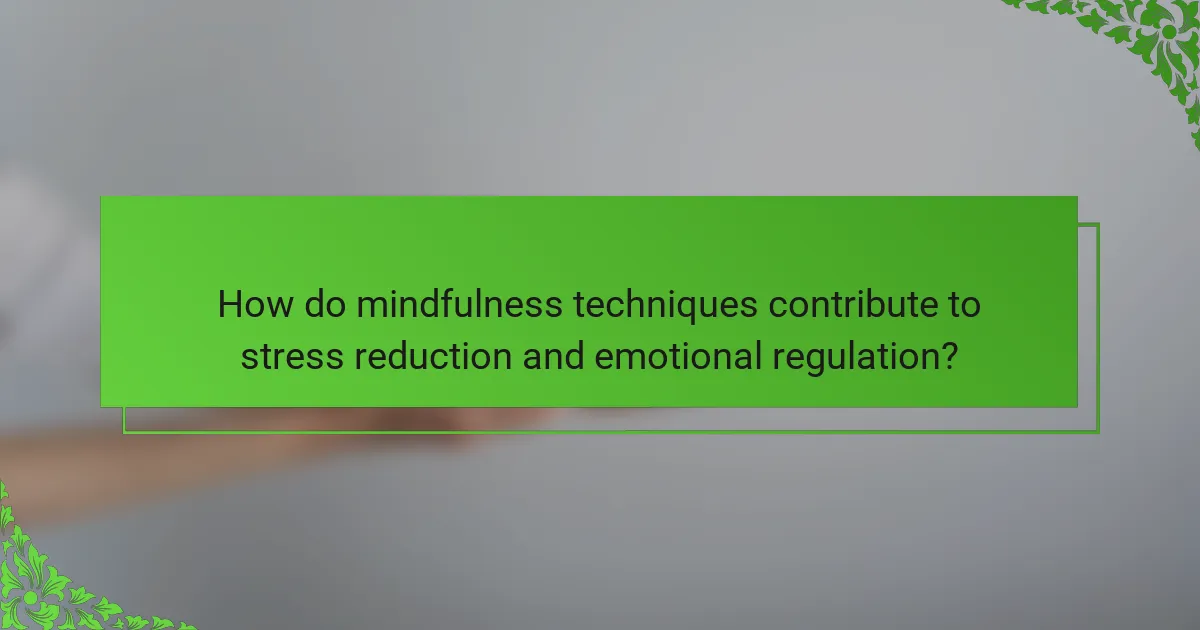
How do mindfulness techniques contribute to stress reduction and emotional regulation?
Mindfulness techniques significantly reduce stress and enhance emotional regulation. These practices promote awareness and acceptance, which help individuals manage their emotional responses effectively.
Mindfulness meditation, for instance, encourages focusing on the present moment, reducing anxiety and stress levels. Research shows that consistent mindfulness practice can lower cortisol, a key stress hormone. Techniques such as deep breathing and body scans further enhance emotional resilience by fostering a sense of calm and control.
Engaging in mindfulness regularly can lead to improved emotional regulation, allowing individuals to respond rather than react to stressors. This shift can result in better decision-making and healthier relationships.
What are the psychological mechanisms behind mindfulness for stress relief?
Mindfulness enhances stress relief by promoting awareness and acceptance of present experiences. It activates the parasympathetic nervous system, reducing stress responses. Key psychological mechanisms include attention regulation, emotional acceptance, and cognitive flexibility. These mechanisms enable individuals to respond to stressors more effectively and maintain emotional balance. Research indicates that consistent mindfulness practice can lower anxiety levels and improve overall well-being.
Which mindfulness techniques are most effective for emotional regulation?
Mindfulness techniques such as deep breathing, body scanning, and mindful meditation are effective for emotional regulation. These practices help reduce stress and enhance self-awareness, allowing individuals to respond to emotions more constructively.
Deep breathing involves focusing on the breath, which can lower heart rate and promote relaxation. Body scanning encourages awareness of physical sensations, helping to identify and release tension. Mindful meditation fosters a non-judgmental observation of thoughts and feelings, leading to improved emotional resilience.
Research indicates that regular practice of these techniques can significantly decrease anxiety and depression levels. For instance, a study found that participants who practiced mindfulness reported a 30% reduction in emotional distress.
Incorporating these techniques into daily routines can lead to lasting improvements in emotional regulation and overall well-being.
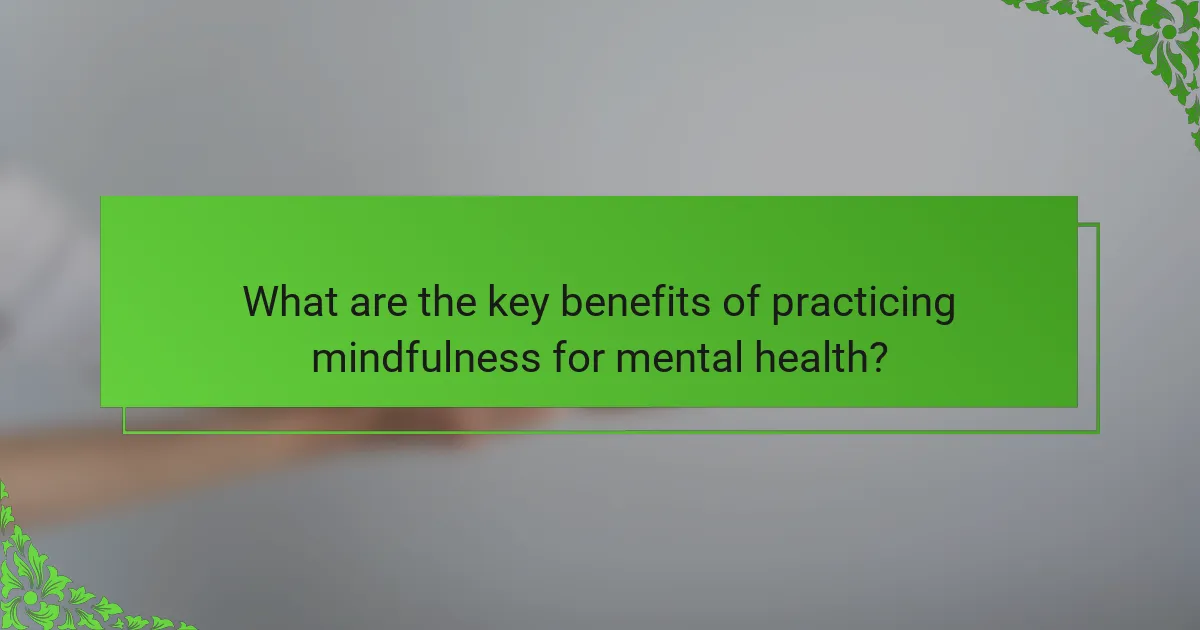
What are the key benefits of practicing mindfulness for mental health?
Practicing mindfulness offers significant benefits for mental health, including reduced stress and improved emotional regulation. Mindfulness techniques help individuals become more aware of their thoughts and feelings, allowing for better management of anxiety and depression.
Research shows that mindfulness can decrease cortisol levels, promoting a calmer state of mind. Regular practice enhances emotional resilience, enabling individuals to respond to challenges more effectively. Additionally, mindfulness fosters a greater sense of self-awareness, which can lead to healthier relationships and improved overall well-being.
Mindfulness can be practiced through various techniques, such as meditation, deep breathing exercises, and mindful movement. These practices encourage individuals to focus on the present moment, reducing rumination and negative thought patterns. As a result, many practitioners report increased feelings of happiness and life satisfaction.
In summary, the key benefits of mindfulness for mental health include stress reduction, enhanced emotional regulation, improved self-awareness, and greater overall well-being.
How does mindfulness improve focus and attention?
Mindfulness enhances focus and attention by promoting present-moment awareness and reducing distractions. Techniques such as meditation and breathing exercises train the brain to concentrate better. Research indicates that consistent mindfulness practice can increase attention span and improve cognitive flexibility. As a result, individuals often experience heightened productivity and improved emotional regulation.
In what ways does mindfulness enhance emotional resilience?
Mindfulness enhances emotional resilience by promoting awareness and acceptance of thoughts and feelings. It reduces stress, improves emotional regulation, and fosters a positive mindset. Mindfulness practices, such as meditation and breathing exercises, strengthen coping mechanisms against adversity. Research shows that individuals practicing mindfulness report lower anxiety and greater emotional stability.
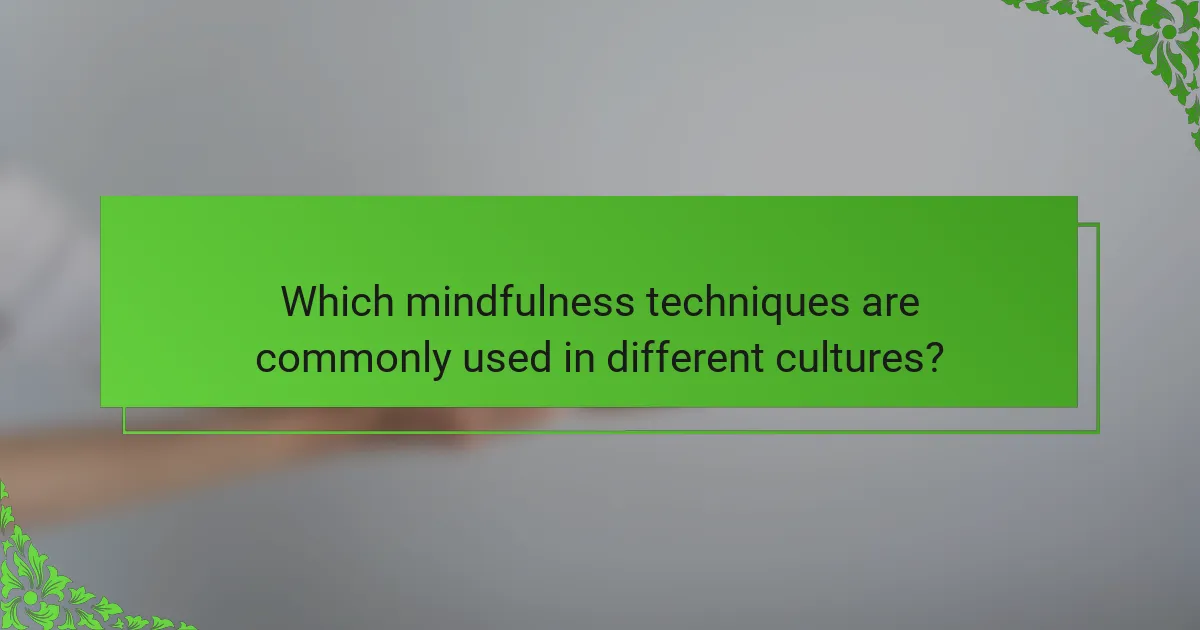
Which mindfulness techniques are commonly used in different cultures?
Mindfulness techniques vary across cultures, each offering unique practices for stress reduction and emotional regulation. Common techniques include meditation, breath awareness, and mindful movement.
In Asia, mindfulness often incorporates meditation practices. For instance, Zen Buddhism emphasizes seated meditation to cultivate awareness. In India, yoga combines physical postures with breath control to enhance mental clarity and emotional stability.
Western cultures frequently adapt mindfulness through therapeutic practices. Mindfulness-Based Stress Reduction (MBSR) is a structured program that integrates meditation and body awareness, helping individuals manage stress and anxiety.
Indigenous cultures utilize nature-based mindfulness practices. For example, Native American traditions often include rituals that connect individuals to the land, promoting emotional healing and community bonding.
What role does meditation play in mindfulness practices?
Meditation is essential in mindfulness practices as it cultivates awareness and emotional balance. It enhances stress reduction by promoting relaxation and reducing anxiety. Regular meditation fosters a deeper connection to the present moment, which is crucial for effective emotional regulation. Studies show that mindfulness meditation can decrease cortisol levels, leading to lower stress responses. Additionally, it strengthens neural pathways associated with emotional control, making practitioners more resilient to stressors.
How do breathing exercises differ across mindfulness traditions?
Breathing exercises in mindfulness traditions vary significantly in technique and focus. Different traditions emphasize distinct aspects, such as awareness, control, or relaxation.
In Buddhist mindfulness, breathing techniques often center around awareness and observation. Practitioners focus on the natural rhythm of breath, promoting presence and acceptance. In contrast, yoga traditions frequently incorporate breath control (pranayama) to enhance physical and mental well-being. This method emphasizes regulation of breath to influence energy flow and emotional states.
Additionally, Tai Chi integrates breath with movement, fostering a holistic connection between body and mind. This practice emphasizes fluidity and harmony, contrasting with the stillness found in Zen meditation. Each tradition offers unique approaches, yet all aim to cultivate mindfulness and emotional regulation through breath.
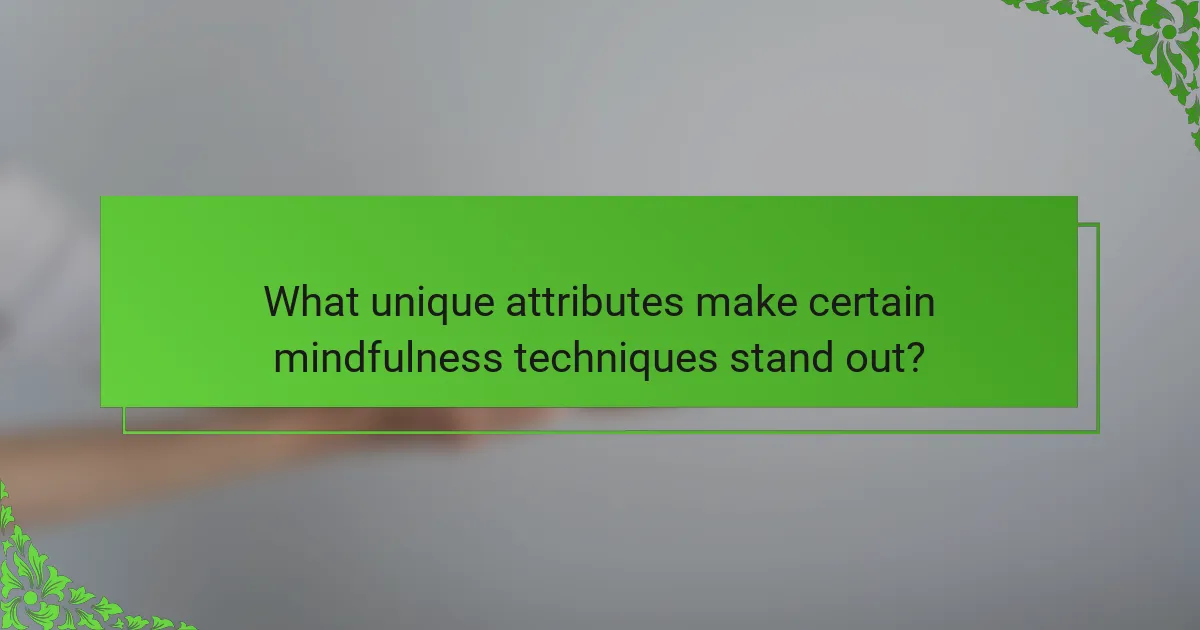
What unique attributes make certain mindfulness techniques stand out?
Certain mindfulness techniques stand out due to their unique attributes that enhance effectiveness. Techniques like body scanning provide immediate physical awareness, while loving-kindness meditation fosters emotional connection. Breath-focused practices are often cited for their accessibility, allowing practitioners to engage anytime. Additionally, guided imagery techniques can create vivid mental landscapes that promote relaxation. These distinctive traits contribute to their popularity in stress reduction and emotional regulation.
How does the integration of technology enhance mindfulness practices?
Technology enhances mindfulness practices by providing tools that improve focus and accessibility. Apps and wearables offer guided meditations, real-time stress monitoring, and personalized feedback. These innovations foster engagement and consistency, making mindfulness more approachable. For example, meditation apps can track progress and encourage daily practice, leading to better emotional regulation. Additionally, virtual reality experiences can create immersive environments for mindfulness, enhancing relaxation and stress reduction.
Which mindfulness apps are popular among users in 2025?
Popular mindfulness apps in 2025 include Headspace, Calm, Insight Timer, and Smiling Mind. These apps focus on stress reduction and emotional regulation through guided meditations and mindfulness techniques. Headspace offers personalized plans, while Calm emphasizes sleep and relaxation features. Insight Timer provides a vast library of free content, appealing to diverse user needs. Smiling Mind targets specific age groups, making it unique in its approach. Each app has gained a strong user base due to its effective techniques and user-friendly interfaces.

What challenges do individuals face when adopting mindfulness techniques?
Individuals face several challenges when adopting mindfulness techniques, including difficulty in maintaining focus, managing expectations, and overcoming resistance to change. Many struggle with intrusive thoughts that disrupt practice, making it hard to achieve the desired state of calm. Additionally, the time commitment required can feel overwhelming, leading to frustration. Lastly, some may experience skepticism about the effectiveness of mindfulness, hindering their commitment to the practice.
How can beginners overcome common barriers to mindfulness practice?
Beginners can overcome common barriers to mindfulness practice by starting small and gradually increasing their commitment. Setting realistic expectations helps reduce frustration. Establishing a consistent routine fosters habit formation, while using guided resources can provide structure. Engaging in community support offers motivation and accountability.
What misconceptions about mindfulness hinder its effectiveness?
Misconceptions about mindfulness can significantly reduce its effectiveness. Common myths include the belief that mindfulness is solely about relaxation or that it requires emptying the mind completely. These misunderstandings can prevent individuals from fully engaging with mindfulness practices.
Another misconception is that mindfulness is only beneficial for stress relief, while it also enhances emotional regulation and overall well-being. Some people think mindfulness is a quick fix, overlooking its need for consistent practice to achieve lasting benefits.
Lastly, the idea that mindfulness is a one-size-fits-all approach ignores the unique attributes of individual experiences and needs. Personalizing mindfulness techniques can lead to more effective outcomes in stress reduction and emotional regulation.

How can mindfulness techniques be tailored for specific populations?
Mindfulness techniques can be tailored to specific populations by considering their unique needs and circumstances. For instance, children may benefit from playful mindfulness exercises, while older adults might prefer gentle breathing practices.
Individuals with anxiety can focus on grounding techniques, while those with chronic pain may find body scan meditations more effective. Adjusting the duration and complexity of practices can enhance accessibility for diverse groups.
Cultural relevance is also crucial; incorporating familiar elements can foster engagement. Tailoring mindfulness approaches ensures they resonate and provide maximum benefit to each population.
What adaptations are necessary for mindfulness in workplace settings?
Adaptations for mindfulness in workplace settings include incorporating regular mindfulness breaks, creating a supportive environment, and offering training programs. These strategies enhance stress reduction and emotional regulation among employees. Regular mindfulness practices, such as meditation or deep breathing, help employees manage stress effectively. A supportive environment encourages open communication and reduces stigma around mental health. Training programs equip staff with necessary skills, fostering a culture of mindfulness. Implementing these adaptations can lead to improved well-being and productivity.
How can mindfulness be effectively taught to children and adolescents?
Mindfulness can be effectively taught to children and adolescents through engaging techniques. Incorporating activities like breathing exercises, guided imagery, and mindful movement fosters emotional regulation and stress reduction.
1. **Breathing Exercises**: Teach children to focus on their breath, promoting relaxation and awareness.
2. **Guided Imagery**: Use storytelling to help them visualize calming scenarios, enhancing mental clarity.
3. **Mindful Movement**: Incorporate yoga or simple stretches to connect body awareness with mindfulness.
4. **Gratitude Journals**: Encourage writing about positive experiences to shift focus from stress.
5. **Mindfulness Games**: Use fun activities that promote attention and presence, making learning enjoyable.
6. **Consistent Practice**: Establish a routine to reinforce mindfulness, helping children integrate these techniques into daily life.
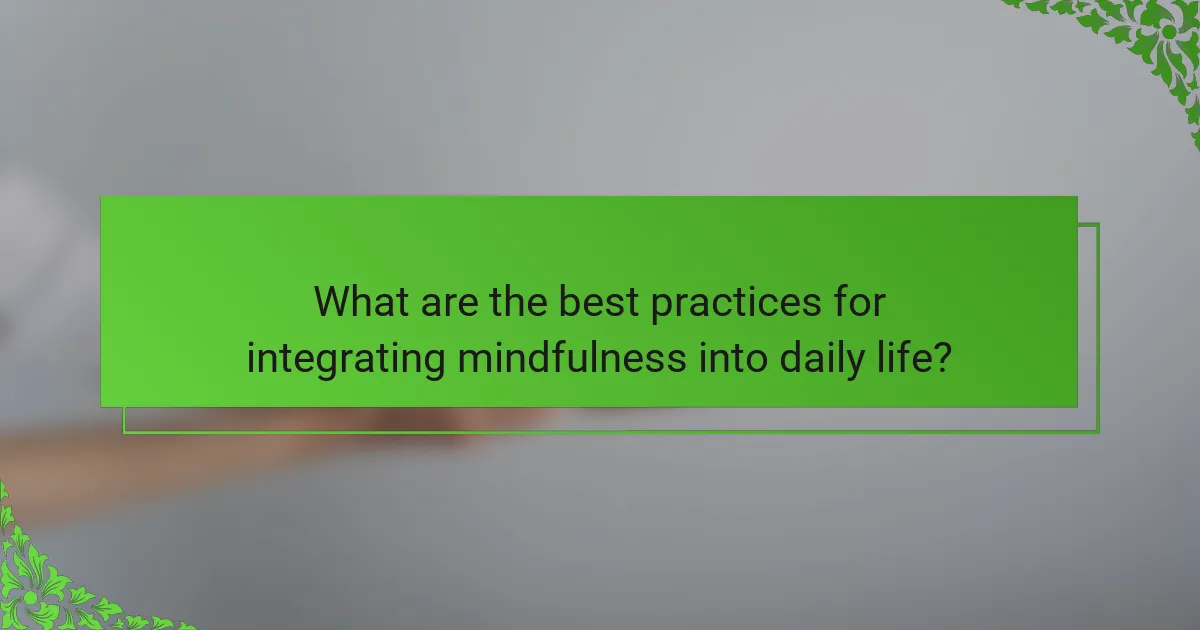
What are the best practices for integrating mindfulness into daily life?
To integrate mindfulness into daily life, practice daily meditation, mindful breathing, and body scans. These techniques reduce stress and enhance emotional regulation. Set specific times for mindfulness, such as morning routines or breaks during the day. Use reminders to stay consistent, and engage in mindful activities like walking or eating. Over time, these practices can improve overall well-being and resilience.
How can individuals create a sustainable mindfulness routine?
Individuals can create a sustainable mindfulness routine by integrating consistent practices into their daily lives. Start with simple techniques such as focused breathing, which can enhance emotional regulation and reduce stress.
Establish a specific time each day dedicated to mindfulness, such as morning meditation or evening reflection. This consistency reinforces the practice and builds a habit.
Incorporate mindfulness into everyday activities, like mindful eating or walking, to deepen the experience. These practices can enhance awareness and promote a calm mindset throughout the day.
Track progress and adjust techniques as needed. Keeping a journal can help individuals reflect on their experiences and identify which methods are most effective for their personal growth.
What expert tips can enhance the effectiveness of mindfulness techniques?
Incorporating expert tips can significantly enhance mindfulness techniques for stress reduction and emotional regulation. Focus on consistency by practicing daily, even for short durations. Utilize guided meditations to deepen your practice and ensure proper technique. Create a dedicated space for mindfulness to foster a conducive environment. Lastly, integrate mindfulness into daily activities, such as eating or walking, to reinforce its benefits throughout your day.
